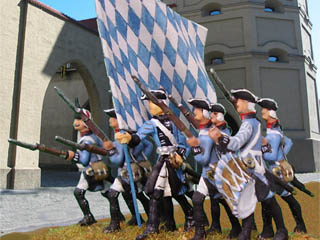Leib-Regiment Kurfürst in Bayern
Electorate of Bavaria 1756–1763

The owner of the Leib-Regiment was the current Elector (Kurfürst) of Bavaria. By decree dated 28 August 1753, the regiment was reduced from 4 battalions with 4 grenadier and 20 füsilier companies to only 3 battalions with 3 grenadier und 12 füsilier companies. The supernumerary companies were used to raise a new regiment which the Kurfürst offered to Generalmajor Joseph Heinrich Freiherr von Pechmann by executive ordinance of 4 Mai (SGBH, 121).
From April 1757, the Leib-Regiment deployed its III. battalion for service with the Auxiliar-Korps of the Austrian army. In July, the II. battalion also joined the Auxiliar-Korps. Both field battalions returned to their Munich garrison in January 1759, and spent the remainder of the war in Bavaria. In 1760, new uniforms with black facings and bastion-shaped buttonhole lace were issued.
Owner
- Max Joseph III. Kurfürst in Bayern, 20 January 1745–1777
Commanding Officer
- Oberst Ferdinand Freiherr von und zu Freyen-Seyboltstorff, 1756–1759
- Generalmajor Joseph Heinrich Freiherr von Pechmann, 1759
- Generalmajor Johann Christian Joseph Freiherr von Herold, 1759
- Generalmajor Franz Joseph Cervatius von la Rosée, 27 June 1764
- Oberst Joseph Alexander de Lamotte, 1774
Garrison
- Munich (4 battalions with 4 Gren. und 20 Füs. Komp.), 1749
- Munich (2 battalions) and Landshut (2 battalions), 1751
- Munich (3 battalions with 3 Gren. und 12 Füs. Komp.), 1 October 1751
Organisation
- Regimentsstab – Regimental Staff
- I. Leib-Bataillon (life guard battalion)
- 1. Grenadier-Kompanie
- 1. (Leib)Kompanie
- 2. Kompanie
- 3. Kompanie
- 4. Kompanie
- two 3-pfünder Bataillonsgeschütze (btl. guns)
- II. Obristen-Bataillon (colonel’s battalion)
- 2. Grenadier-Kompanie
- 5. Kompanie
- 6. Kompanie
- 7. Kompanie
- 8. Kompanie
- two 3-pfünder Bataillonsgeschütze
- III. Obristen-Bataillon
- 3. Grenadier-Kompanie
- 9. Kompanie
- 10. Kompanie
- 11. Kompanie
- 12. Kompanie
- two 3-pfünder Bataillonsgeschütze
Two companies formed a division of the regiment, numbered from the flanks toward the center. Battalion guns were deployed on both flanks of a battalion, or on the flanks, and between the 3rd and 4th division of the regiment.
Illustrations
- Knötel-Sieg: Handbuch der Uniformkunde, pp. 50-52
- Mollo, John: Uniforms of the Seven Years’ War, 1756-63, Plate 62
- Bilderlexikon der Uniformen von 1700 bis zur Gegenwart, Südwest Verlag
- Deutsche Uniformen im Zeitalter Friedrichs des Großen, Sturm Zigaretten, Dresden
Uniform
- blue coat with white buttons
- white collar
- white lapels with 8 buttons and buttonhole lace right and left
3 buttons and buttonhole lace below left and right lapels - white cuffs with three buttons and buttonhole lace
- white turnbacks
- white shoulder strap on the left
- black stock
- white vest (Kamisol) with white buttons
- white breeches
- black gaiters with white buttons
- black tricorne hat with white border, black cockade, white-blue pompom (SGBH, 291), and company badge (SGBH, 293)
- füsiliers of the Leib-Regiment had cartridge pouches with brass grenade badges normally reserved for grenadiers
- dark brown fur grenadier caps with red bag, white lace and pompom
- drummers wore uniforms with reversed colours, and black-and-blue lace chevrons, until 1760. When the Leib-Regiment adopted the new uniform with black facings and white buttonhole lace in 1760, the drummers received the same uniform as the men, but they retained the old black-and-blue lace.
- officers on duty wore the yellow metal aiguillette
- officers’ horses wore dark blue, (later light blue) saddle blankets with white borders (SGBH, 308), and matching pistol holster covers.

These 40 mm Prince August miniatures of the Leib-Regiment are wearing the blue uniform with black facings introduced in 1760. The miniatures have been mounted on 100 mm wide and 50 mm deep bases compatible with the Volley & Bayonet game system. The ensign is a conversion of the dismounted cavalryman from Prince August mould PA46, who has had his pistol removed and a pianowire flagstaff placed into his hand.
Campaign History
- Mobilization of the III. battalion for service in the Auxiliarkorps, 6 April 1757
- II. bataillon leaves Munich to join the Auxiliarkorps, 25 July 1757
- Siege of Schweidnitz, 1757
- Battle of Breslau, 1757
- Battle of Leuthen, 1757
- Capture of Troppau, 1758
- Siege of Olmütz, 1758
- Siege of Neiße, 1758
- Return from campaign, January 1759
Lineage
- 10. Bayerisches Infanterie-Regiment König, 1902
- 20. (Bayerisches) Infanterie-Regiment, 5. Kompanie, 1921
From 1760, black facings with white bastion-shaped buttonhole lace replaced the old white facings of the Leib-Regiment.